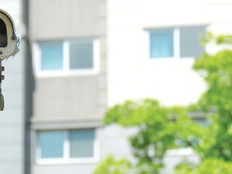Smart Cards Could Be the Future of Campus Access Control
Just as chip-and-pin has become the latest in credit card technology, smart cards — plastic cards with built-in microprocessors — seem to be what’s next for access control on university campuses.
The latest statistics from Ingersoll Rand Security Technologies show that while the majority of college campuses use magnetic stripe cards and more than half still use keys for access, 9 percent of universities have turned to smart cards — and that number is growing.
This fall, Northwestern University switched from using physical keys to smart cards — to enter both the building and the rooms themselves — in four of their residence halls.
“The management of hard keys is antiquated and something we were trying to move away from,” says Paul Riel, the executive director of residential services at Northwestern. “We were really looking forward to having current technology.”
The redesigned Northwestern WildCARDs are HID iCLASS access cards that work with the interior and exterior locks connected to the university’s wireless network.
With the latest in technology, universities are seeing huge updates in their security and efficiency.
Increased Security Meets Ease and Efficiency
In addition to making residence halls more secure, Art Monge, the manager of Northwestern’s WildCARD program says that as a research institution that receives millions of dollars in grants, the university also switched their research facilities, which were using magnetic stripe cards, to the smart cards as well.
“We implemented more secure proximity technology and through the agreement we have with the vendor, we have an encrypted code on each chip that is unique to Northwestern,” says Monge.
So on the rare chance that someone is able to duplicate the chip used in a WildCARD, Monge says it still wouldn’t work on campus because it would lack the encrypted code.
Daniel Pascale, the vice president of Margolis Healy, a firm that specializes in security at educational institutions, agrees that one of the biggest benefits of smart cards over magnetic stripe cards is the counterfeiting protection.
“Smart card technology is obviously the wave of the future. It provides a much higher level of security than magnetic stripe cards, which an average college student can figure out how to replicate,” Pascale says.
With smart cards also come smart locks, which recognize the credential on the card and whether or not that person has permission to access that door at that time.
Miami University of Ohio has had smart cards in place since 2012, replacing locks on 4,300 interior doors and 900 exterior doors with wireless access solutions, reports an article on security solutions provider CBORD’s website.
CBORD’s access control solution monitors when a card is being used several times in a row at locations it doesn’t have credentials for, which can indicate it may have been stolen, and deactivates it at that point. The smart lock also reports when a door has been propped open.
Riel says a lost or stolen card is no longer a worry at Northwestern. Lost smart cards can be not only instantly deactivated, but also quickly replaced. Because the WildCARDs are produced on campus, a student can receive a new one almost immediately.
“Compared to the old lock and key, it’s a time difference of maybe four hours from the point it is reported to when the incident is closed. It just makes us more efficient,” says Riel.
Also, unlike with magnetic stripe cards, there is no worry that a card could be accidently demagnetized or worn out by swiping, so cards can be used for significantly longer, Monge says.
Best Practices for Rolling Out New Access Control
At Northwestern, Riel says representatives from residential services, university police, facilities management and the IT department were part of a committee that chose the new access control option.
“Having the IT department at all of these meetings was critical for us,” says Riel. “We needed to know that our wireless network had the capacity to handle these locks.”
After the network was upgraded to provide high-definition TV across campus, Riel says it was robust enough and that no additional upgrades were needed for the smart card rollout.
As with any new solution, when rolling out an updated access control system like smart cards, Pascale says universities need to involve all stakeholders in the process.
“It needs to be a decision by all of those stakeholders because each one’s operation is affected differently,” he says. “If universities fail to be inclusive, they are setting themselves up for long-term failure.”








